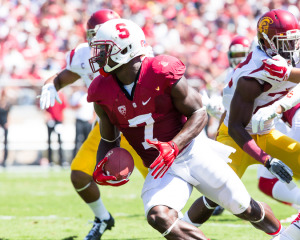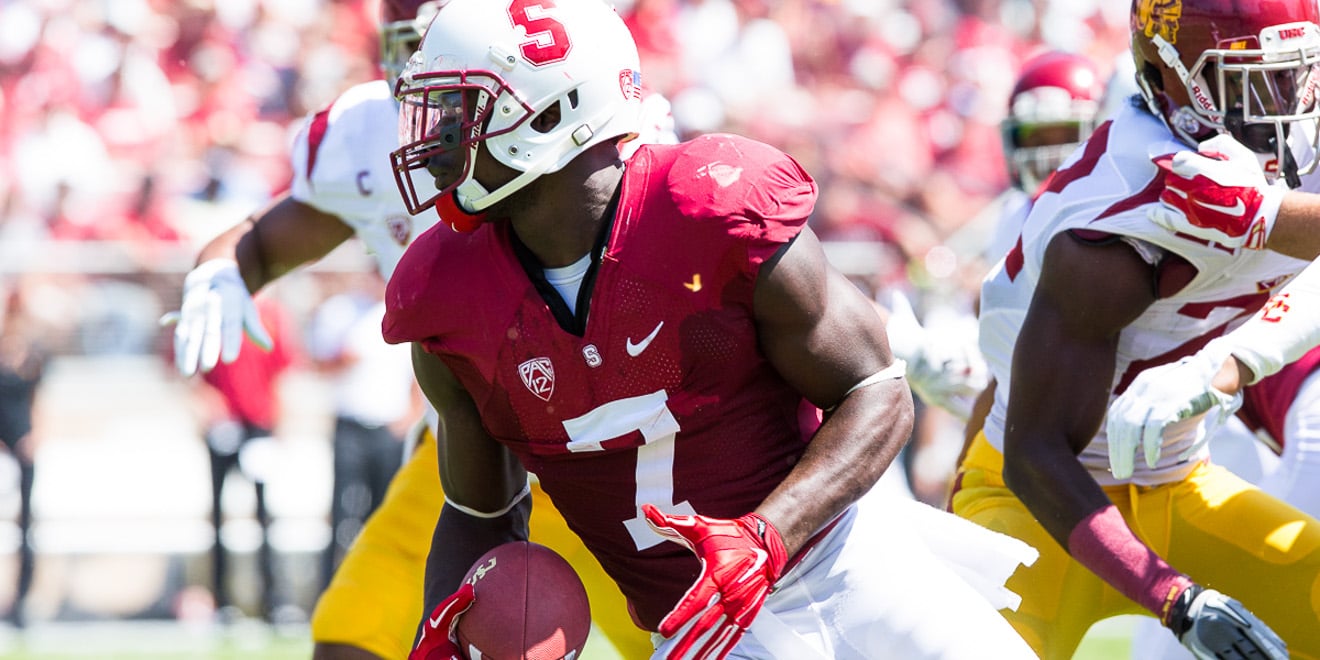Stanford is an institution known for solving the unsolvable, but there’s one baffling problem on the Farm these days that even leaves Nobel laureates scratching their heads: How do you fix Cardinal football?

It’s not so much the 4-3 record that’s disappointed fans — looking at the brutal schedule in the preseason, it was conceivable that the Cardinal could finish 9-3 even if they played well. The frustration centers on the manner in which Stanford has lost games, specifically on offense.
Stanford’s offense has been outplayed, outcoached and out-toughed for long stretches in games this season, a worrisome development that Cardinal fans have not seen in at least five years.
“I’ve got to do a better job on offense giving our guys chances to be successful,” said head coach David Shaw. “We can’t just continue to do what we’ve been doing. We’ve got to make some changes, and it’s got to come from me.”
Shaw shouldered the full blame in Tuesday’s press conference, but while his willingness to protect his players is admirable, it’s hard to deny that the players’ execution on offense is, at the bare minimum, equally responsible for the three losses. The Cardinal’s plight is magnified by the fact that there is no one culprit.
Where once there was a workhorse halfback who took five defenders with him to the ground, now there is a horde of running backs struggling to stay on their feet. In place of impeccable offensive-line play, there are now back-to-back false starts. Savvy quarterback scrambles have been swapped with bad sacks.
It doesn’t make sense. It’s not Stanford football.
As the Cardinal looks to right the ship in its homecoming game against Oregon State on Saturday, we examine three problems that Stanford’s offense must fix if the team hopes to have any shot at a third-straight Pac-12 title.
Montgomery’s absence
Senior wide receiver Ty Montgomery has hardly touched the ball on offense, an understated problem that’s been lost amidst all of Stanford’s struggles. He’s averaging eight total touches per game, including catches and running plays. He has dipped from 15.7 yards per catch last year to just 10.3 this season, and his four offensive scores so far on the season are nowhere close to matching the pace of 12 touchdowns that he collected in 2013.
Shaw himself pointed out that Montgomery’s average of six receptions per game is nowhere close to what the coaching staff wants. Stanford may be a run-first offense, but it’s not giving itself much of a chance if the most dynamic player on the field is getting just eight touches per game. Yes, defenses have keyed in on the wideout, but that doesn’t mean Stanford should give up on finding creative ways to get the ball to Montgomery.
For an analogy, if defenses load the box against Stanford, the Cardinal wouldn’t abandon running the ball, would they? The first step towards improving on offense for Stanford is rediscovering its identity, and Montgomery is, more than ever, a major part of that identity. Bubble screens won’t work on a consistent basis, but more fly sweeps, pick plays with crossing routes and double moves should help increase Montgomery’s production. Also, as erratic as senior quarterback Kevin Hogan has been this season, he’s delivered some good throws to Montgomery in big games that should have been caught — those are mistakes that the senior can’t make from here on out.
No running game
Stanford’s rushing statistics this season are a bit misleading. On the surface, the Cardinal’s 4.3 yards per rush seem passable, but the story is different when you take a closer look at their performance against top-25 opponents. Stanford’s rushing attack averaged 2.73 yards per carry in its three losses, and in its last two defeats, the team has been held to under 80 yards on the ground. What’s also interesting is that the Cardinal have not had much success running to the outside, as they’ve experimented with when the power running game was failing.
It’s difficult to pinpoint whether the anemic running game is the fault of the offensive line or the running backs — it’s most likely a combination of both position groups — but what’s known for sure is that Stanford’s offense cannot function without establishing the run.
There are two situations that the Cardinal are not built for: playing from behind and converting third-and-long situations. And if Stanford can’t run the ball, Hogan and company are going to face many more third-and-longs this season.
What might be more surprising is the fact that Stanford hasn’t seemed comfortable with running power on third-and-short. On multiple occasions, the Cardinal have lined up in the shotgun formation on third-and-2, and that’s just something Stanford fans aren’t used to seeing.
The pass blocking in the backfield has also been a major concern for the coaching staff. Senior tailback Remound Wright was supposedly the best pass-blocker heading into the season, but the two chop-block penalties that he’s been flagged for raise serious concerns for how the offense can pick up blitzes and protect Hogan. Which finally leads us to…
A sitting duck
Hogan has never been a fantastic pocket passer, and the coaching staff has unsuccessfully tried to make him one. It’s been frustrating for Cardinal fans to see him sit in the pocket and not run the power read, or roll out on bootlegs. Shaw has defended Hogan’s play — and not without reason — but this is a situation where the coach can help his quarterback by simplifying the game for him. Hogan earned Shaw’s trust by mastering plays specifically designed for dual-threat quarterbacks, and it might be a good time for Shaw to bring the Hogan packages back.
Contact George Chen at gchen15 ‘at’ stanford.edu.
